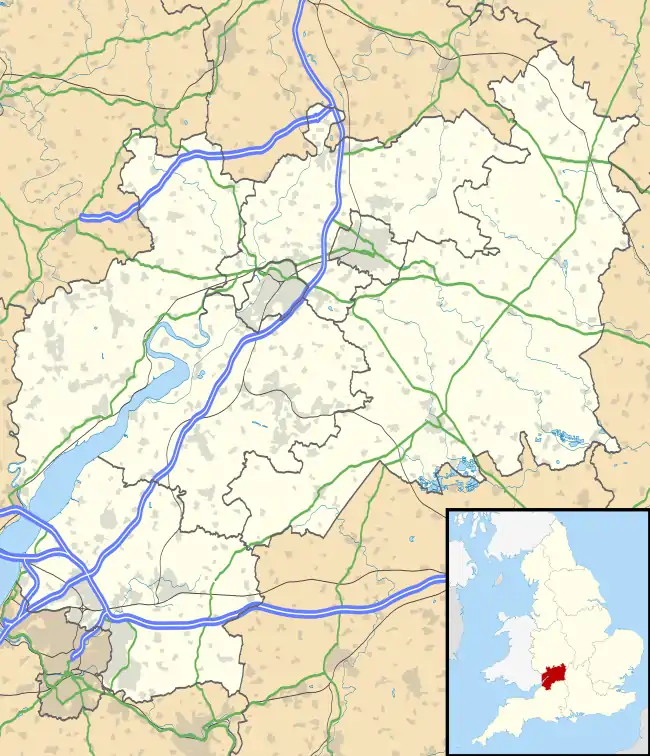Wimberry Quarries
Wimberry Quarries (grid reference SO594121) is a 2-hectare (4.9-acre) nature reserve in Gloucestershire in the Forest of Dean.[1]
| Wimberry Quarries | |
|---|---|
 Example - Oak-fern (Gymnocarpium dryopteris) | |
 Wimberry Quarries shown within Gloucestershire | |
| Type | Gloucestershire Wildlife Trust nature reserve |
| Location | near Coleford |
| Coordinates | 51°48′23.48″N 2°35′22.3″W |
| Area | 5 acres (2.0 ha) |
| Operated by | Gloucestershire Wildlife Trust |
| Status | Open all year |
The site is managed by the Gloucestershire Wildlife Trust and held under agreement with the Forestry Commission.[1] The site is listed in the 'Forest of Dean Local Plan Review' as a Key Wildlife Site (KWS).[2]
Location and site
The quarries are about one and a half miles to the north-east of Coleford. The name comes from the steep-sided Wimberry Slade, which is one of several dry and narrow valleys. These run east-to-west along the edge of the Cannop Valley. The reserve is on the south slope and is made up of four quarries and their spoil tips. They lie within a large area of mixed woodland. There has been conifer-planting in the area.[1]
These are disused quarries and have been little disturbed since they were closed. There is a blocked off tunnel which would have originally been used to take stone from one of the quarries. The largest of the four quarries has a 25 m vertical rock face which exposes the Pennant Sandstone of the Dean Coal Measures. This exposure shows thin, variable coal seams.[1]
The site is accessible from forest tracks from the Cannop Valley up Wimberry Slade or from Mile End via Perch Lodge. There is a safety fence near the edge of the quarries.[1]
Flora
The quarry floors and rock faces have been colonised by a variety of ferns, mosses and flowers. A significant fern present is Oak Fern as this is one of the few locations in the Forest of Dean where it has been recorded. The Slade is a good location for ferns and at least 10 species have been recorded. Common Wintergreen is also present and is relatively rare west of the River Severn.[1]
There is a terrace of open heathland at the top of the quarries which is between the safety fence and the edge. This area supports Bilberry and Heather. There is a plantation of Larch and Spruce.[1]
The natural colonisation of the quarry floors and spoil tips has created a mixed woodland area of Pedunculate Oak, Beech, Ash, Sweet Chestnut and Birch. These have spread from the mixed woodland surrounding the quarries.[1]
Conservation
Whilst the general policy is minimum interference and natural regeneration, excessive tree-growth is contained and the heathland is kept clear of scrub which would destroy it.[1]
Walks
There is a publication which details places to visit for recreation, and for observing particular wildlife in this part of the Forest of Dean.[3]
Publications
- Kelham, A, Sanderson, J, Doe, J, Edgeley-Smith, M, et al., 1979, 1990, 2002 editions, 'Nature Reserves of the Gloucestershire Trust for Nature Conservation/Gloucestershire Wildlife Trust'
- ‘Nature Reserve Guide – discover the wild Gloucestershire on your doorstep’ - 50th Anniversary, January 2011, Gloucestershire Wildlife Trust
- 'Where to see Wildlife in the Forest of Dean', January 2012, Gloucestershire Wildlife Trust
References
- Kelham, A, Sanderson, J, Doe, J, Edgeley-Smith, M, et al., 1979, 1990, 2002 editions, 'Nature Reserves of the Gloucestershire Trust for Nature Conservation/Gloucestershire Wildlife Trust'
- Forest of Dean District Local Plan Review, adopted November 2005, Appendix D 'Nature Conservation Site Designations Within the Forest of Dean District', Key Wildlife Sites
- 'Where to see Wildlife in the Forest of Dean', January 2012, Gloucestershire Wildlife Trust